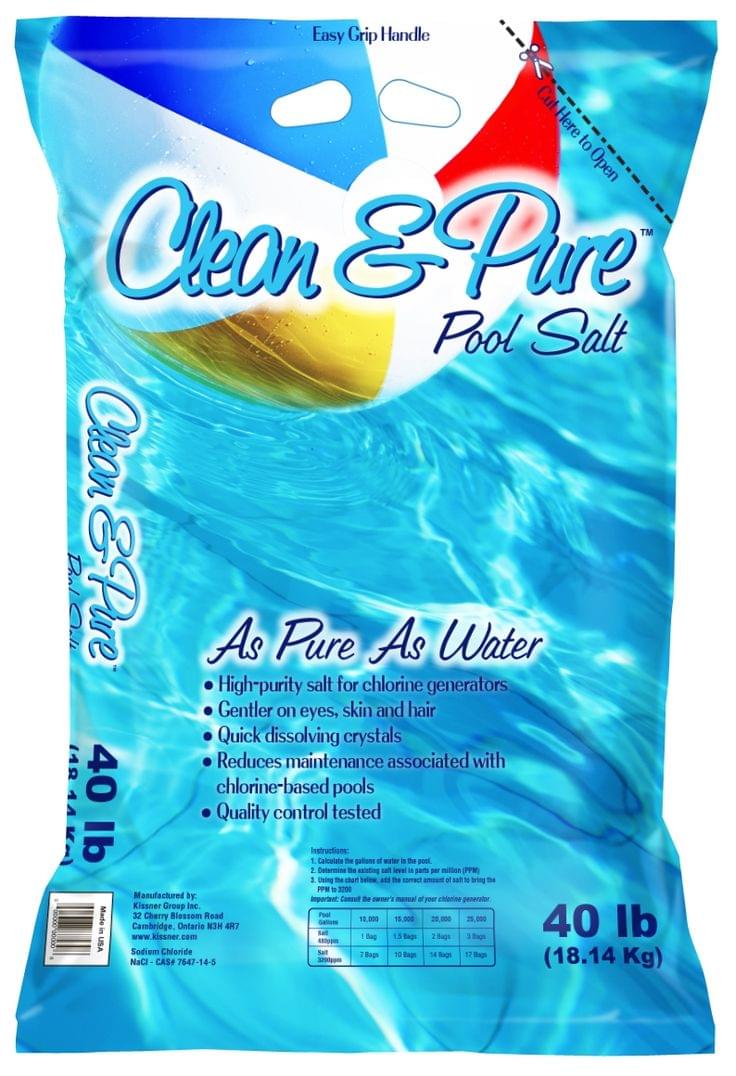How Much Salt to Add to Your Swimming Pool
If you’re asking this question, you’ve probably already invested in a salt chlorine generator. Once you familiarize yourself with your new chlorinator you’ll enjoy higher water quality with less effort. Don't have a salt chlorine generator yet? Click here to shop our above ground salt chlorinators, or click here to browse our inground salt chlorinator line up, then return to this page to determine the amount of salt you require.
How Much Salt Do You Need?
The salt level required to maintain a safe, salt water chlorinated pool is between 2500 and 3500 PPM (parts per million). The human tongue cannot taste salt until the parts per million of salt is close to 5000, and the ocean has a salt content of approximately 40,000 parts per million. To identify how much salt you should add to your pool, you first need to...
Size Your Pool
To size your pool in gallons (G), take the area of the pool (A) and multiply it by the average depth (AD), then, multiply that number by 7.48.
G = A x AD x 7.48
To find your average depth (AD), add your deep end (D) and your shallow end (S) measurements, then divide that sum by two.
AD = (D + S) / 2
The table below will give you an idea of how much salt may be necessary to reach the desired level of 3500 ppm.
| Size of Pool |
Volume (Gallons) |
Volume (Liters) |
# of 20 Kg Bags |
Total Amount of Salt (Kg) |
| 13 X 24 ft |
6,477 |
24,517 |
4.5 |
90 |
| 14 X 22 ft |
7,248 |
27,435 |
5 |
100 |
15 X 25 ft |
8,377 |
31,708 |
5.5 |
110 |
| 15 X 29 ft |
9,690 |
36,677 |
6.5 |
130 |
| 16 X 32 ft |
11,334 |
42,901 |
7.5 |
150 |
| 17 X 30 ft |
11,663 |
44,146 |
8 |
160 |
| 19 X 35 ft |
15,692 |
59,398 |
10.5 |
210 |
| 17 X 28 ft |
8,814 |
33,363 |
6 |
120 |
| 20 X 30 ft |
10,791 |
40,846 |
7 |
140 |
| 20 X 36 ft |
12,633 |
47,819 |
8.5 |
170 |
*Important Note: All pool sizes above are based on a constant depth and shape; the actual amount of salt required may vary.

Where to Find Pool Salt
When in season, pool salt can be found at your local hardware store - stores like Wal Mart or Costco may also stock pool salt. Pool salt is usually sold in 20, 40 or 80 pound bags. When you’re buying your pool salt, it’s important to use sodium chloride (NaCl) that is at least ninety-eight per cent pure. Preferably, make sure the salt is evaporated granulated, food quality, and non-iodized.
It’s also worth remembering that the finer the quality of salt the more quickly it will dissolve. For example, over sixty per cent of granulated salt will dissolve before it reaches the bottom of your pool. This is an important factor to consider when making your purchase. Undissolved salt can damage the colour of your pool’s lining.
Add Salt to Your Pool in Four Simple Steps
Now that you’ve gathered all the relevant information, it’s time to start adding the salt to your pool.
Step 1. Measuring the Current Salt Level
A brand new pool will have no salt but if you’re replacing a standard chlorinator then you may have around 500 ppm. This is important to take into account when calculating how much salt you should use.
We recommend that you measure your salt levels as part of your regular pool maintenance routine. This measurement will give you a more accurate salt reading, so you know exactly how much salt to add to your pool’s water.
Step 2. Turn off Your Salt Chlorine Generator
Turn your chlorinator off at the control unit and don’t turn it back on until the salt has completely dissolved. Leaving the pump on will help keep the water cycling and dissolve the salt more quickly.
Step 3. Adding the Salt
Do not pour the salt directly into the skimmer. Instead, add the salt to the shallow end of the pool. Want to spare your back all that heavy lifting? Simply line up the salt bags along the edge of your pool. Then, cut a hole in the bottom of the bag and let the salt spill out on its own. Let the salt dissolve completely (which may take about a day) so it can disperse evenly throughout your pool. We recommend that you add a little less than your calculations recommend. Adding more salt is easier than compensating for too much.
Step 4. Test the Pool
To test the salinity of the pool, first turn on the chlorinator and then check to see that the salt has reached the desired level.
Why Are Salinity Levels Important?
Why is it important to get the right level of salt in your pool? A low salt level will reduce efficiency and a high level will shorten the chlorinator’s life span. Once you’ve spent the time doing the math (and ensuring your calculations are accurate) to determine the ideal level of salt for your pool you’ll find that maintaining the right salinity in your pool is simple.




